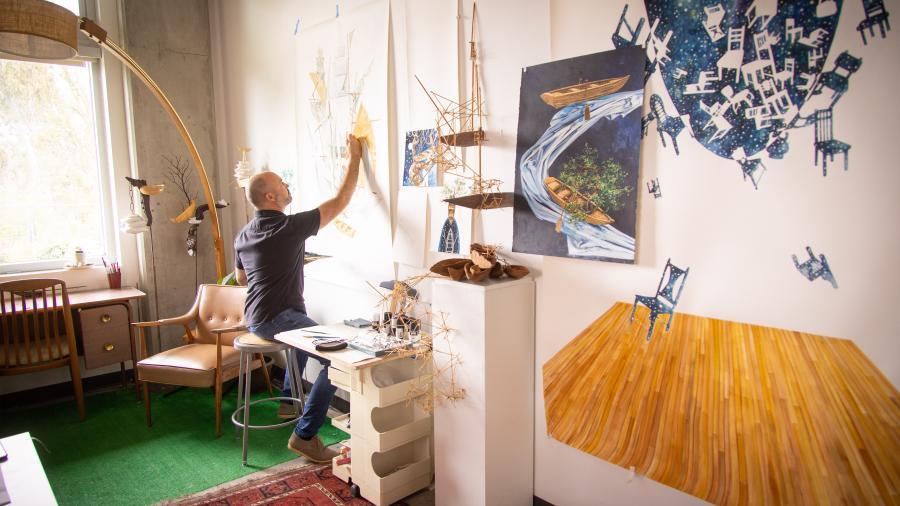Westmont Magazine Making Art Out of Ordinary Life

Nathan Huff explains why art fits so well in a liberal arts curriculum. “Drawing offers another way to encounter the world and use our powers of observation,” he says. “Students come away with a greater sense of nuance and wonder from seeing creation through the act of artmaking. I love teaching; it’s so invigorating. Student conversations open new avenues of thought for me. Art is such a balm for living, and it’s soothing to be with students as they discover this.”
During the pandemic, Huff taught drawing in the dance studio, where students could spread out. He split his painting class between three classrooms, with lectures in one and students working in the others. The drawing and painting studios all have walls that open to the outside like garage doors, providing essential ventilation. He also took classes outdoors for plein-air painting. Restrictions on the number of students in the studio meant he was teaching some in person and others online at the same time.
“Remote teaching was a steep learning curve for all of us,” he says. “I had three cameras going at all times: a Zoom camera on me, a camera on the demo table, and an iPad camera on the still life we were painting. I had to learn how to do a split screen in Zoom. I found it important to get up, walk around, use my body and be in physical space after being disembodied on Zoom.
“I tried to think about other ways of developing proximity when we’re distanced. Could students generate content and narratives from someone else’s perspective and make art based on that? Students texted me images, and I learned how to correct their work digitally. For one exercise, two students plotted a location equidistance from them and met there to create an art installation, building both physical and emotional connections.”
Huff produces both paintings and art installations. One of his pieces includes a bed sculpture with embedded glasses, a line of glasses along the floor, a statue of cascading pillows, and partially woven baskets hanging from the ceiling. For another, a stream of 500 glasses with dozens of small, handmade boats set among them, he bought glassware at thrift shops.
“I’m interested in objects from domestic life that we can infuse with some magical narrative or other way of thinking about them to reveal their undercurrents,” he says. “With the glasses, I was thinking about sustenance and the preservation of life and resources—being a collective community yet having distinctive experiences, like a river versus individual glasses. Objects carry stories: the glass is either half full and half empty, for example.”
His upcoming show at Sullivan Goss in November 2021 will reflect his experience during the pandemic, exploring our deep emotional and physical currents in connection and absence.
A voracious artist from an early age, Huff created countless images of ducks, both warriors and princesses. “I was always telling stories with my drawings, with a duck viewing the drawing in the corner,” he says. He planned a career teaching high school English until his parents and his professors at Azusa Pacific pushed him toward art.
“I realized art was a viable way to see the universe and participate in life,” he says. He earned a Master of Fine Arts in drawing and painting at CSU Long Beach and also studied at Watts Atelier School of Art. He joined the Westmont art faculty in 2013. His solo museum and gallery exhibitions have appeared in California, Oregon and Salambo, Tunisia.
Huff watches his two daughters, 4 and 2, process the world through drawing and play. “They’ve made me more efficient as an artist,” he says. “I bring a different level of energy and curiosity to what I make as a result of having.” He says his wife, Erica, is their family anchor and expresses her creativity through making music and upholstering furniture.
“When I slow down enough to paint and make art, deeper meaning and comprehension come into play and provide a way to deal with sadness and joy,” he says.
Find more images at nathanhuff.com.